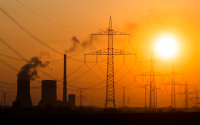By David A. FahrentholdWashington PostSunday, March 1, 2009
The U.S. House of Representatives has abandoned a plan to make its offices "carbon neutral," a sign that Congress is wrestling with a pledge to become more green even as it crafts sweeping legislation on climate change.
The promise that the House would effectively reduce its greenhouse gas emissions to zero was a centerpiece of the Green the Capitol program in which the new Democratic leadership sought to use Capitol Hill as a kind of a national demonstration project.
But last week, a spokesman for the House's chief administrative officer said the chamber's leadership had dropped an essential part of the plan, the purchase of "carbon offsets" to cancel out emissions from its buildings. Offsets are a controversial commodity that promises that a certain amount of pollution was captured or avoided elsewhere.
"Right now, there is no plan to purchase more offsets," spokesman Jeff Ventura said. The House paid $89,000 for offsets to cover the last session, in 2007 and 2008.
The decision comes as legislators also struggle with the future of the Capitol Power Plant: Hundreds of demonstrators with Greenpeace, the Rainforest Action Network and other groups will protest tomorrow against the plant's continued use of coal.
Both issues, the proper use of offsets and the right way to clean up old smokestacks, will probably come up in the national debate over climate change measures expected this year.
Congress is learning that even in its back yard, the weeds get pretty deep.
"It's very easy to make glib promises and a heck of a lot harder to follow through with real action" on climate change, said Frank O'Donnell of the nonprofit group Clean Air Watch. "In the cold light of reality, I guess, they're saying, 'Gee, it's not going to happen very easily.' "
The Green the Capitol program, announced in June 2007, has made major changes in the way the Hill moves, works and eats.ad_icon
Four hybrid Zipcars are now available in House garages. The House supply store sells only 100 percent post-consumer recycled paper. And Capitol cafeterias have switched to biodegradable plates, locally grown foods and a composting system that has cut waste.
In addition, the House aimed to be the "World's First Carbon Neutral Legislative Body." Although the Senate promised to become greener, it not go that far.
The first step in the House's plan was to reduce energy use in its buildings. Workers replaced light bulbs in thousands of office lamps and made vending machines and air conditioners more efficient. And the House has paid Pepco extra for power from wind farms.Still, planners said, emissions remain. For example, the House gets the steam for its heat from the Capitol Power Plant. In addition to burning coal, the plant uses natural gas.
So the House turned to offsets. In 2007, it paid a market, the Chicago Climate Exchange, for offsets equaling 30,000 metric tons of carbon dioxide.
But The Washington Post reported last year that although the money was funneled to projects that captured greenhouse gases or avoided their emission, many had been completed before the House paid a cent. Experts said those issues make it hard to say that the House's money had caused the environmental benefits the chamber paid for.
"Maybe they're admitting that what we did [in purchasing offsets] was actually nothing," said Rep. Dan Lungren (Calif.), the ranking Republican on the House administration committee, which oversees the office that purchased the offsets.
On Friday, Ventura issued a statement saying that carbon neutrality was no longer the House's goal.
"Although original 'carbon neutrality' targets were achieved [in the last Congress], we recognize a widely accepted standard for 'absolute neutrality' does not exist, nor is there any formal accreditation process to certify an organization is carbon neutral," Ventura said. "Therefore, the second phase of Green the Capitol will focus on the continued reduction of carbon and the saving of energy through operational improvements."
This will come up again. Democratic leaders say they want to have a bill ready for debate this summer that would create a "cap-and-trade" system for greenhouse gases.
In such a system, Congress might give polluters the option of buying offsets. A power plant might pay to plant trees elsewhere in the United States or around the world, for example, because the trees capture carbon dioxide as they grow.
"It is a complicated decision," said Katherine Hamilton of the analysis group Ecosystem Marketplace. "They're going to have to decide: What are the criteria that create a viable offset? [How should they] set out the rules on how people play the game?"ad_icon
The Capitol Power Plant has also been a sticky issue -- and a more obvious one because its smokestacks are just blocks from the Capitol. After a request from the House, the plant is burning more natural gas, which produces about half the greenhouse gas emissions of coal.
But it continues to burn about 35 percent coal. At last count, it was the biggest single source of several air pollutants in the District, according to the D.C. Department of the Environment.
On Thursday, House Speaker Nancy Pelosi (D-Calif.) and Senate Majority Leader Harry M. Reid (D-Nev.) wrote to the Architect of the Capitol office, which runs the plant, proposing that it be converted to run only on natural gas.
But the office has estimated that the conversion would cost $7.78 million. And officials with the agency are unsure how long it would take. Lungren and Senate Minority Leader Mitch McConnell (R-Ky.) say they still want to use the plant to find ways to burn coal more cleanly.
Tomorrow's protest will argue that a change at the Capitol Power Plant should be only the beginning of a national shift from coal power. Organizers say they plan to form human chains to block the plant's entrances, and accept arrest if they have to.






